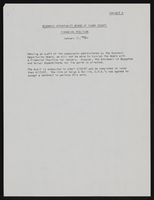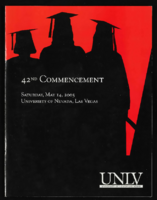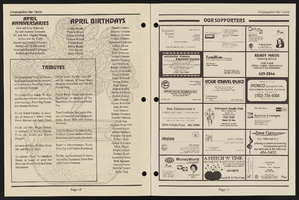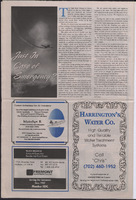Search the Special Collections and Archives Portal
Search Results
George Kelly Ryan Photograph Collection
Identifier
Abstract
The George Kelly Ryan Photograph Collection (1929) depicts waterways in Southern Nevada and Northern Arizona. The collection consists of eight photographic prints and two photographic negatives depicting Saint Thomas, Black Canyon, Boulder Canyon, and the Colorado River.
Archival Collection
Apolonio Sauceda Scrapbooks
Identifier
Abstract
The Apolonio Sauceda Scrapbooks (1973-2010) document Apolonio "Loney" Sauceda's acting career and his work with the Nevada Association for Latin Americans (NALA) in Las Vegas, Nevada. Two scrapbooks document Sauceda's career as an actor and contain photographs of Sauceda on set, at premieres, with other actors, and depict movie sets at well-known Las Vegas hotels and casinos in the 1980s and 1990s. Newspaper clippings accompany many of the photographs and provide details about locations, major actors, or the producers for each film. The third scrapbook is compiled of newspaper clippings that document the local Las Vegas, Nevada Latinx community and NALA events in the 1970s, ranging from political activism, labor strikes, beauty pageants, and religious gatherings.
Archival Collection
Gue Gim Wah Papers
Identifier
Abstract
The Gue Gim Wah Papers (approximately 1940-1985) consist primarily of incoming correspondence (largely written in Chinese) to Gue Gim Wah at the Prince Mine in Pioche, Nevada. Also included are Wah's naturalization certificate, a map of the Prince Mine Bunkhouse, brochure of the Lincoln County Civic Association, and a small amount of photographs including a black-and-white photograph of Gue Gim circa 1940s.
Archival Collection
Cherina Kleven Papers
Identifier
Abstract
The Cherina Kleven Papers (approximately 1988-2014) document the career of Cherina Kleven who was the first Asian-American appointed as Assistant Fire Chief for Las Vegas Fire & Rescue. The materials primarily include physical and digitized photographs of Kleven in her capacity as Assistant Fire Chief, magazine and newspaper articles featuring Kleven, and event programs. Also included are campaign fliers from 2010 when Kleven ran for office to represent Assembly District 15 in the Nevada Legislature as well as two commemorative books celebrating the history of Las Vegas Fire & Rescue.
Archival Collection
William J. Moore Jr. Photograph Collection
Identifier
Abstract
The William J. Moore Jr. Photograph Collection (approximately 1942-1960) consists of black-and-white photographic prints, negatives, and one oversize image depicting William "Bill" J. Moore Jr.'s career as a casino operator in Las Vegas, Nevada. Images include events at the Moore family home and the Hotel Last Frontier. Also included are images of Moore with politicians, casino operators, and other notable figures in Las Vegas.
Archival Collection

Economic Opportunity Board of Clark County (Nev.) financial and budget reports
Date
Archival Collection
Description
From the Clark County Economic Opportunity Board Records -- Series I. Administrative. This folder contains financial memos and reports of the Clark County Economic Opportunity Board in 1967.
Text

University of Nevada, Las Vegas (UNLV) 42nd commencement program
Date
Archival Collection
Description
Commencement program from University of Nevada, Las Vegas Commencement Programs and Graduation Lists (UA-00115).
Text
Katherine A. Spilde Papers on Native American Gaming
Identifier
Abstract
The Katherine A. Spilde Papers on Native American Gaming include materials collected by anthropologist Katherine Spilde about Native American gaming and the greater gaming industry. The materials date from 1789 to 2015, with the bulk of materials dating from 1995 to 2010. Materials dating from the eighteenth and nineteenth centuries are reproductions of key court opinions and treaties concerning Native American rights and sovereignty. The majority of the materials document Native American gaming following the passage of the 1988 Indian Gaming Regulatory Act (IGRA). The papers detail Native American gaming enterprises both on and off reservations, the socioeconomic impact of gaming, and the legislative history of Native American gaming in the United States. The papers include research and subject files created by Dr. Spilde during her employment with the National Gambling Impact Study Commission (NGISC), the National Indian Gaming Association (NIGA), and the Harvard Project on American Indian Economic Development (HPAIED). The collection includes socioeconomic reports; testimonies; correspondence; memos; press releases; photographs; audiovisual materials; promotional materials from casinos and tourist attractions; brochures; fact sheets; summaries; booklets; pamphlets; advertisements; tourism materials; journal articles; legal briefs; legislative documents; court opinions; Dr. Spilde’s notes; presentations; packets, agenda, schedules, and itineraries from conferences; periodicals; Native American and community newspapers; and newspaper articles. The collection includes materials about over one hundred federally recognized Native American nations. Also included are materials that document the socioeconomic impact of gaming, the international gaming industry, criminal activities related to gaming, advertising about gaming and casinos, lotteries, internet gaming, compulsive gambling, and bankruptcy as a result of gambling.
Archival Collection


